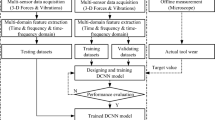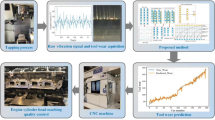Abstract
The parts with integrated design technology are widely used in aerospace field because of their advantages such as high strength and high reliability compared with riveted structures, which often present multiple cavities and thin walls, and milling occupies a large amount of machining time, while it is very easy to cause rapid degradation of tool performance because their materials are mostly made of hard-to-machine metals. To address the failure of traditional methods in monitoring the tool trajectory of complex cavity milling process, this paper proposes a tool wear prediction method based on a short-time Fourier transform and an improved depth residual network. Firstly, the short-time Fourier transform is used to convert the signal into a time-frequency map. Then, to solve the problem that the depth residual network describes the machining state from a single perspective, the original model is improved by adding a feature fusion layer. Finally, the signal and the time-frequency map are simultaneously input into the improved deep residual network, and the tool wear sensitive features filtered by Pearson correlation coefficient are extracted from the time domain and frequency domain of the signal, and the deep features in the time-frequency domain are extracted from the residual block structure of the time-frequency map, and the tool wear sensitive features and the deep features in the time-frequency domain are fused in the feature fusion layer to complete the model training. The experimental results show that the average prediction deviation of tool wear by the regression model established in this paper is 0.76%, which is lower than that of the original deep residual network, shallow convolutional neural network, and artificial feature-based machine learning model.



















Similar content being viewed by others
Data Availability
Not applicable
References
Liangshi S, Chengying Z, Xianzhen H et al (2023) Cutting tool remaining useful life prediction based on robust empirical mode decomposition and Capsule-BiLSTM network. Proc Inst Mech Eng Part C: Journal of Mech Eng Sci 237(14):3308–3323
Ferrando Chacón JL, Fernández de Barrena T, García A, Sáez de Buruaga M, Badiola X, Vicente J (2021) A novel machine learning-based methodology for tool wear prediction using acoustic emission signals. Sensors 21:5984. https://doi.org/10.3390/s21175984
Han D, yu J, Tang D (2020) An HDP-HMM based approach for tool wear estimation and tool life prediction. Qual Eng 33:208–220
Geramifard O, Xu JX, Zhou JH et al (2014) Multimodal hidden Markov model-based approach for tool wear monitoring. IEEE Trans Ind Electron 61(6):2900–2911
Shawe-Taylor J, Sun SL (2011) A review of optimization methodologies in support vector machines. Neurocomputing 74(17):3609–3618
Madhusudana CK, Kumar H, Narendranath S (2017) Face milling tool condition monitoring using sound signal. Int J Syst Assur Eng Manag 8(2):1643–1653
Wang GF, Yang YW, Zhang YC et al (2014) Vibration sensor based tool condition monitoring using ν support vector machine and locality preserving projection. Sensors Actuators A Phys 209:24–32
Binsaeid S, Asfour S, Cho SH et al (2009) Machine ensemble approach for simultaneous detection of transient and gradual abnormalities in end milling using multisensor fusion. J Mater Process Technol 209(10):4728–4738
Zhou YQ, Xue W (2018) Review of tool condition monitoring methods in milling processes. Int J Adv Manuf Technol 96(5-8):2509–2523
Liu C, Wang GF, Li ZM (2015) Incremental learning for online tool condition monitoring using ellipsoid ARTMAP network model. Appl Soft Comput 35:186–198
Baig RU, Javed S, Khaisar M, Shakoor M, Raja P (2021) Development of an ANN model for prediction of tool wear in turning EN9 and EN24 steel alloy. Adv Mech Eng 13(6). https://doi.org/10.1177/16878140211026720
Torabi AJ, Er MJ, Li X et al (2016) Application of clustering methods for online tool condition monitoring and fault diagnosis in high-speed milling processes. IEEE Syst J 10(2):727–732
李志猛. 基于声发射信号的铣削状态监测与聚类诊断理论方法研究[D]. 天津大学, 2018. https://doi.org/10.27356/d.cnki.gtjdu.2018.002919
Lecun Y, Bottou L, Bengio Y et al (1998) Gradient-based learning applied to document recognition. Proc IEEE 86(11):2278–2324
Krizhevsky A, Sutskever I, Hinton G (2012) ImageNet classification with deep convolutional neural networks. In: 26th Annual Conference on Neural Information Processing Systems 2012. Neural Information Processing Systems Foundation, New York, pp 1097–1105
Simonyan K, Zisserman A (2015) Very deep convolutional networks for large-scale image recognition. CoRR abs/1409.1556
He KM, Zhang XY, Ren SQ et al (2016) Deep residual learning for image recognition. In: 2016 IEEE Conference on Computer Vision and Pattern Recognition. Piscataway, IEEE, pp 770–778
Serin G, Sener B, Ozbayoglu AM et al (2020) Review of tool condition monitoring in machining and opportunities for deep learning. Int J Adv Manuf Technol 109(3-4):953–974
Zhang XD, Han C, Luo M et al (2020) Tool wear monitoring for complex part milling based on deep learning. Applied Sciences-Basel. https://doi.org/10.3390/app10196916
Aghazadeh F, Tahan A, Thomas M (2018) Tool condition monitoring using spectral subtraction and convolutional neural networks in milling process. Int J Adv Manuf Technol 98(9-12):3217–3227
Wu L, Sha K, Tao Y, Ju B, Chen Y (2023) A Hybrid Deep Learning Model as the Digital Twin of Ultra-Precision Diamond Cutting for In-Process Prediction of Cutting-Tool Wear. Appl Sci 13(11):6675. https://doi.org/10.3390/app13116675
Code availability
The authors confirm that the code supporting the findings of this work is available from the corresponding author upon reasonable request.
Funding
This work was partially supported by the National Key Research and Development Program of China (2019YFA0706702), the National Natural Science Foundation of China (52075365), the National Natural Science Foundation of China (51721003), and the National Key Research and Development Program of China (2022YFB3303603).
Author information
Authors and Affiliations
Contributions
ZG: conceptualization, experimental data acquisition, methodology code, writing original draft. FW: conceptualization and detailed corrections. GW: supervision, funding acquisition, writing review. HZ: conceptualization.
Corresponding author
Ethics declarations
Ethics approval
The authors declare the compliance with the ethical standards.
Consent to participate
All authors consent to participate.
Consent for publication
All authors consent to publish.
Conflict of interest
The authors declare no competing interests.
Additional information
Publisher’s note
Springer Nature remains neutral with regard to jurisdictional claims in published maps and institutional affiliations.
Rights and permissions
Springer Nature or its licensor (e.g. a society or other partner) holds exclusive rights to this article under a publishing agreement with the author(s) or other rightsholder(s); author self-archiving of the accepted manuscript version of this article is solely governed by the terms of such publishing agreement and applicable law.
About this article
Cite this article
Guan, Z., Wang, F., Wang, G. et al. Improved depth residual network based tool wear prediction for cavity milling process. Int J Adv Manuf Technol 130, 1759–1777 (2024). https://doi.org/10.1007/s00170-023-12829-5
Received:
Accepted:
Published:
Issue Date:
DOI: https://doi.org/10.1007/s00170-023-12829-5




